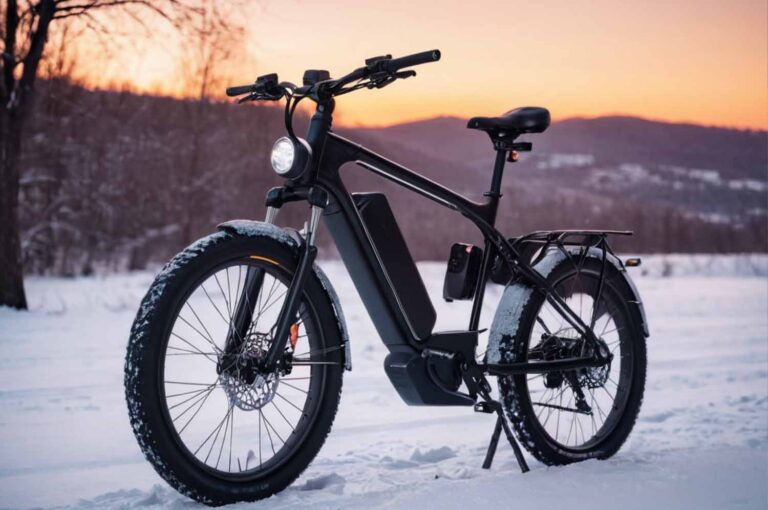Winter E-Biking Essentials: Your Guide to Safety, Battery Care, & Cold-Weather Tips
Winter can transform the daily e-bike commute into a challenging adventure. For beginners, the prospect of e-biking during the colder months may seem daunting, but with the right knowledge, it can be both safe and enjoyable.
Understanding the essentials of cold-weather e-biking is crucial, from maintaining optimal battery life to storing the bike properly.
Equipped with practical tips, e-bikers can extend their riding season and continue to enjoy the benefits of their electric bicycle even as the temperatures drop.
Proper storage solutions are not only about prolonging the life of the e-bike but also about safety and security.
As winter brings with it additional hazards, knowing how to navigate slippery roads and adjust riding techniques is essential for any e-biker.
Moreover, students who rely on their e-bike for commuting can discover the economic advantages that extend beyond fuel savings. By embracing winter e-biking, students can cut commute costs and maintain a level of independence regardless of the weather.
Therefore, it’s important to venture into the world of winter e-biking with a clear understanding of how to get started safely, how to maximize the e-bike’s battery life in the cold, and how to store the bike to keep it in prime condition.
For those ready to face the chill on two wheels, a beginner’s guide to winter e-biking can pave the way to a rewarding experience throughout the season.
Table of Contents
Getting Started with Winter E-Biking
Embarking on winter e-biking requires proper gear selection and an understanding of your electric bicycle’s capabilities to ensure safety and enjoyment during the colder months.
Choosing the Right Gear
When getting ready for winter e-biking, selecting the right gear is crucial. Clothing should be both warm and high-visibility to protect against the cold and ensure other road users can see you.
Helmets are essential not only for safety but also for warmth, with options available that provide additional insulation.
For the e-bike itself, consider equipping fat tires which offer better traction on snowy terrain or studded tires if you’re facing icy conditions.
Tubeless tires can also be beneficial as they tend to have better pinch-flat resistance and can be run at lower pressures for improved grip.
Equip your e-bike with lights at the front and back for visibility, especially during the shorter days of winter.
Understanding Your E-Bike’s Capabilities
Understanding the electric bicycle’s nuances in winter conditions is important for both maintenance and performance. The battery life can significantly decrease in cold weather, so insulate it if possible and keep it charged to maximize efficiency.
Bike prep is crucial: use disc brakes, preferably hydraulic disc brakes, for reliable stopping power in wet and icy conditions, and ensure the suspension is adjusted correctly for a smoother ride over uneven surfaces. It’s advisable to get the e-bike checked at a reputable bike shop before winter hits.
Being familiar with your e-bike’s frame geometry and handling will enhance stability on slippery bike lanes. Always use hand signals to communicate with other road users, avoid distracted cycling, and understand that braking distances may increase on wet or frozen roads.
Maximizing Battery Life
Battery life is crucial for e-bike riders, especially in cold weather. A well-maintained battery retains power longer, ensuring durability and a reliable ride. Here’s what you need to know to keep your e-bike’s battery at its best during the winter months.
Charging Techniques
One vital technique to maximize an e-bike’s battery life is to charge it correctly. Batteries shouldn’t be charged below freezing (0°C/32°F) as it can cause damage and reduce overall lifespan. It’s best to charge the battery at room temperature. To optimize battery life, one should:
- Charge the battery before it’s fully drained: Keeping the battery between 30% to 80% can help maintain its health over time.
- Avoid high voltage charging if possible, to reduce heat stress.
The best practice is to charge the battery indoors in a dry, cool area, as detailed by the experts at Electricwheelers.
Maintenance and Care
Routine maintenance and care are key to prolonging battery life. Users should store the e-bike or its removable battery in a place with stable temperatures, preferably between 55°F and 75°F, even when the e-bike is not in use for an extended period. If storing for more than 30 days, the battery should be charged between 50% to 70%.
To maintain peak performance during colder months, riders should:
- Inspect the battery regularly for any signs of wear or damage.
- Keep the battery clean from grime and road salt, which can lead to corrosion.
Following these specific tips, like those mentioned at RideZoomo, will help e-bikers enjoy a safe, uninterrupted ride through winter’s demanding conditions.
Storing Your E-Bike in Winter
As winter sets in, it’s crucial to store one’s e-bike correctly to maintain its durability and prevent issues such as rust. Proper storage solutions can help extend the life of the bike’s frame, battery, and electronic systems.
Indoor Storage Solutions
For the commuter who relies on their e-bike daily, indoor storage is the best option for the winter months. Keeping the e-bike inside, in places like a garage, basement, or even a dry and temperate utility space, shields it from harsh temperatures that could degrade its electrical components and battery life.
When devising an indoor storage strategy, e-bikers should consider using racks or mounts to keep the e-bike off the ground, this approach not only saves space but also avoids potential moisture from a cold floor.
Protecting from the Elements
Even if an e-biker is short on indoor space, there are ways to protect the e-bike from winter’s elements. Utilizing a high-quality, waterproof cover can guard against snow and rain.
It’s advisable to ensure the cover is well-fitted, allowing for ample airflow to prevent condensation, which could lead to rust on the frame.
Furthermore, adding fenders to the e-bike can help protect its components from road spray and salt that are common during winter commutes.
Safe E-Biking on Winter Roads

Winter e-biking demands heightened awareness and skill, particularly when it comes to navigating slippery roads and bustling urban environments.
These strategic approaches ensure cyclists remain visible and maintain control, no matter the chill.
Handling Skills for Slippery Terrain
On icy or snowy roads, cyclists should minimize sudden moves.
It’s advisable to reduce speed when cornering and avoid harsh braking, which could lead to skidding. Using tires appropriate for winter conditions can provide better grip on gravel or slippery surfaces.
Maintaining a slight bend in the elbows allows for better control over the commuter bicycle and ready maneuverability for any unexpected obstacles.
Navigating Through Traffic and Pedestrians
Visibility is paramount when there’s less daylight. Outfitting the e-bike with a bright front light and flashing rear light helps draw the attention of drivers and pedestrians. Opting for routes known for being bike-friendly can reduce the chances of an accident.
Cyclists should use a bell to alert others when necessary and always wear a bike helmet for safety. When sharing lanes with traffic, predictable hand signals and eye contact with drivers aid in safe commutes in urban settings.



